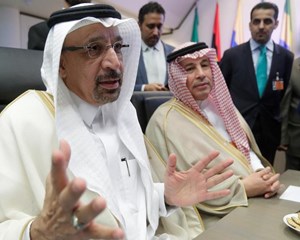Finance & economics
財經板塊
Oil markets
石油市場
Division over the spoils
瓜分戰利品
The latest rift within OPEC is a sign of things to come
石油輸出國組織內部的最新裂痕是事態發展的一個信號
It is rare for spats about oil supply to break out between Saudi Arabia and the United Arab Emirates (UAE). The countries' views on output usually align. Traders and analysts regard them, along with Kuwait, as the core of the Organisation of the Petroleum Exporting Countries (OPEC). So eyebrows were raised in early July when Suhail Al Mazrouei, the UAE's energy minister, told reporters that OPEC's quotas were "totally unfair". A further surprise came on July 5th when meetings between the cartel and its allies (notably Russia), together known as OPEC+, were abandoned because of the row. The price of the benchmark Brent crude rose above $77 a barrel for the first time in more than two years, before dropping back below $75; that of American crude briefly hit a six-year high.
沙特阿拉伯和阿拉伯聯合酋長國(UAE)之間很少發生關于石油供應的爭吵。這些國家對產出的看法通常是一致的。交易員和分析師認為他們和科威特一樣是石油輸出國組織(OPEC)的核心。因此,當阿聯酋能源部長Suhail Al Mazrouei于7月初告訴記者歐佩克的配額“非常不公平”時,人們揚起了眉毛。7月5日,更令人驚訝的是,該組織與其盟國(尤其是俄羅斯)的會議因為爭吵而被放棄。基準布倫特原油價格兩年多來首次升至每桶77美元以上,之后又回落至每桶75美元以下。美國原油價格一度創下六年新高。
OPEC+ introduced swingeing production cuts last spring as covid-19 began to spread, the demand for fuel tanked and the oil price collapsed to below $30 per barrel. More recently the cartel has been carefully increasing supply as demand has revived and oil prices have recovered. The cancelled meeting had been convened with the goal of agreeing on further increases to output after July. At the same time the Saudis and others were also seeking to extend the current regime for assigning cuts to members' production.
去年春天,隨著新冠疫情開始蔓延,燃油需求急劇增加,油價跌至每桶30美元以下,歐佩克+開始大幅減產。最近,隨著需求復蘇和油價回升,歐佩克一直在謹慎地增加供應。這次被取消的會議的目的是就7月以后進一步增產達成一致。與此同時,沙特和其他國家也在尋求延長現有的削減成員國石油產量的機制。

But the UAE wants the quotas, which are based on countries' oil-producing potential in October 2018, to be revised. Its supply capacity has grown by almost a fifth since then, thanks to heavy investment. A third of its production is now sitting idle—a greater share than in any other OPEC+ country.
但阿聯酋希望修改配額,該配額是基于2018年10月各國的石油生產潛力。自那以來,由于大量投資,其供應能力增長了近五分之一。三分之一的石油產量目前處于閑置狀態,這一比例比任何其他歐佩克+國家都要高。
Other members, in particular Saudi Arabia, are reluctant to see production rise too much, however. That is partly because giving way on quotas could mean that countries such as Russia startto make similar demands. But it could also reflect the Saudis' desire to avoid overproduction at a time when non-OPEC producers may expand supply, too.
然而,其他成員國,尤其是沙特阿拉伯,不愿看到產量增長太多。這在一定程度上是因為,在配額方面做出讓步可能意味著俄羅斯等國開始提出類似的要求。但這也可能反映出在非歐佩克產油國可能擴大供應之際沙特希望避免生產過剩。
The usual suspects would have been America's shale producers, who in the past have often increased output when oil prices rise. This time may be different, though. The industry is trying to change its ways, promising to keep a tight rein on oil output,restrain investment and return cash to shareholders.
通常的懷疑對象是美國的頁巖氣生產商,他們過去經常在油價上漲時增加產量。不過這一次可能有所不同。石油行業正試圖改變現狀,承諾嚴格控制石油產量,限制投資,并向股東返還現金。
譯文由可可原創,僅供學習交流使用,未經許可請勿轉載。











